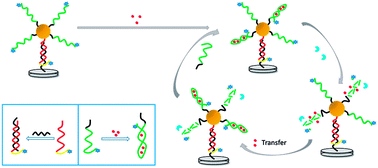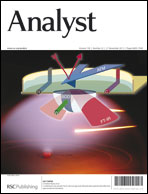An ultrasensitive electrochemical method for detection of Ag+ based on cyclic amplification of exonuclease III activity on cytosine–Ag+–cytosine†
Abstract
Ag+ is known to bind very strongly with cytosine–cytosine (C–C) mismatches in DNA duplexes to form C–Ag+–C base pairs. Exonuclease III (Exo III) can catalyze the stepwise removal of mononucleotides of duplex DNA. In this work, we study Exo III activity on DNA hybrids containing C–Ag+–C base pairs. Our experiments show that Ag+ ions could intentionally trigger the activity of Exo III towards a designed cytosine-rich DNA oligonucleotide (C-rich probe) by the conformational change of the probe. Our sensing strategy uses this conformation-dependent activity of Exo III, which is controlled through the cyclical shuffling of Ag+ ions between the solid DNA hybrid and the solution phase. This interesting conversion has led to the development of an ultrasensitive detection platform for Ag+ ions with a detection limit of 0.03 nM and a total assay time possible within minutes. This simple detection strategy could also be used for the detection of other metal ions which exhibit specific interactions with natural or synthetic bases.


 Please wait while we load your content...
Please wait while we load your content...